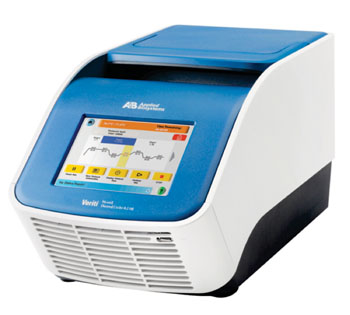High-Risk Female Groups Screened for Fabry Disease
By LabMedica International staff writers
Posted on 26 Jun 2014
Although measurement of lysosomal α-galactosidase A (α-GAL) in women is not accurate for the diagnosis of Fabry disease (FD), determining the range of the enzyme activity presented by heterozygous females could become a valuable tool for minimizing the burden of screening by DNA sequencing all potential carriers. Posted on 26 Jun 2014
This strategy would diminish the total number of sequencing reactions and, by consequence, greatly reduce the costs and the time needed for diagnosis, especially in those centers without high-throughput technologies, and can be implemented by establishing the range of enzyme in dried blood spots (DBS), plasma and leukocytes that suggests carrier status for FD.

Image: The Applied Biosystem Veriti Thermal Cycler (Photo courtesy of Life Technologies).
Geneticists at the Universidade Federal do Rio Grande do Sul (Porto Alegre, Brazil) analyzed blood samples from 453 female patients with clinical suspicion of Fabry disease. Whole blood genomic DNA was extracted for genotyping and polymerase chain reactions were performed in a Veriti Thermal Cycler (Applied Biosystems, Foster City, CA, USA) and sequencing was done in Applied BioSystems’ ABI3500 genetic analyzer. Results of α-GAL activities in 377 DBS and/or 93 plasma and/or 88 leukocytes were obtained from patients' laboratory records.
From the 453 samples sequenced, 54 were heterozygous for pathogenic galactosidase, alpha (GLA) mutations. Thirteen previously described pathogenic mutations were found; most of them, in more than one patient. All patients carrying pathogenic mutations were called “heterozygotes” and those who do not were named as “controls”. The median α-GAL activity in DBS was 3.7 ± 3.2 nmol/h/mL in heterozygotes and 6.2 ± 3.5 nmol/h/mL in controls. In leukocytes and plasma heterozygote means were 23.9 ± 11.6 nmol/h/mg protein and 4.5 ± 2.5 nmol/h/mL, and control values were 41.6 ± 13.1 nmol/h/mg protein and 11.1 ± 5.4 nmol/h/mL, respectively.
Plasma and leukocyte activities presented high area under the curve (AUC) in receiver operating characteristic (ROC) curve analysis, both over 84%. When cutoffs were altered to identify all carriers, leukocyte specificity at 35.2% was higher than that of plasma at 27.6%. Moderated correlation and agreement coefficients were found between them, which reinforces the need for using both data combined.
The authors concluded that a combined approach involving plasma and leukocyte α-GAL activities, with distinct cutoffs for men and women, could represent a more accurate, faster and less expensive tool to screen women for FD in high-risk groups in middle- and low-income countries. Fabry disease (FD) is a rare X-linked inborn error of metabolism caused by deficient activity of lysosomal α-galactosidase A (α-GAL). Due to random X inactivation, α-GAL activity in heterozygous females ranges from very low to overlapping normal values. The study was published in the May 2014 issue of the journal Clinical Biochemistry.
Related Links:
Universidade Federal do Rio Grande do Sul
Applied Biosystems














